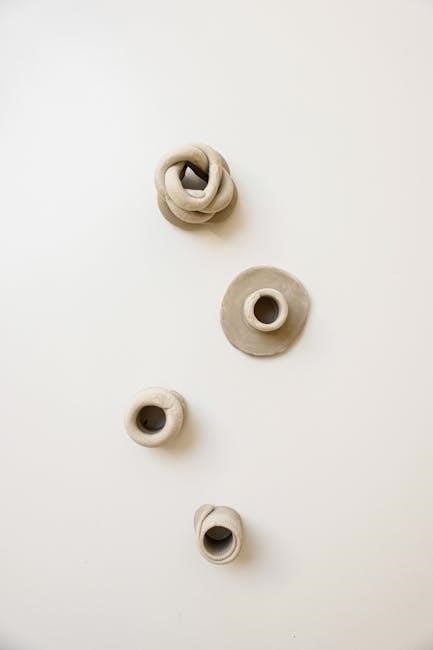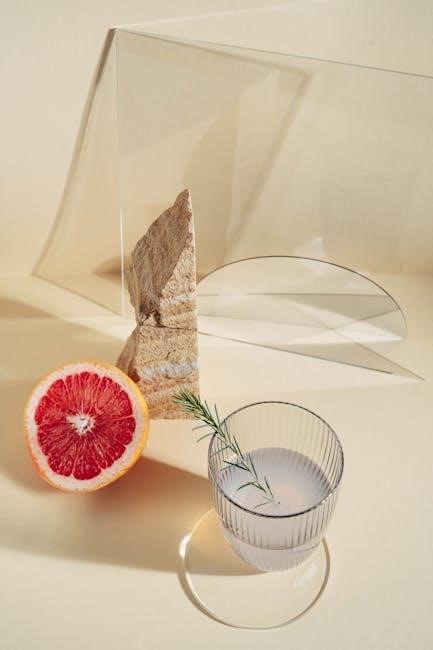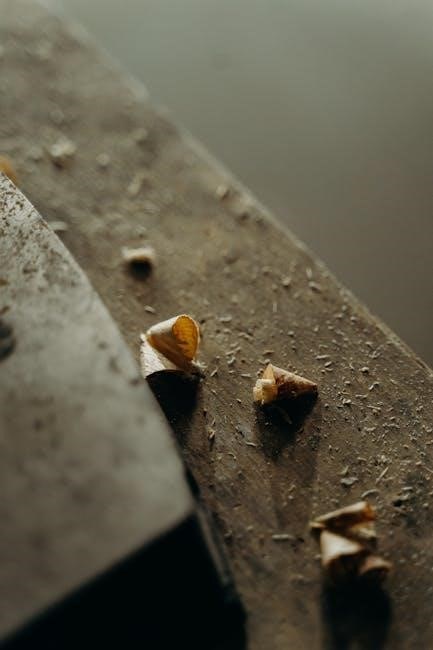
Earning the Brownie Shapes in Nature Badge encourages girls to explore and appreciate the mathematical wonders of the outdoors. Through activities like tracking natural objects, creating symmetry, and counting birds, Brownies develop observation skills and a deeper connection to nature while learning about shapes and patterns.
1.1 Overview of the Badge
The Brownie Shapes in Nature Badge is designed to help girls explore and understand the natural world through the lens of mathematics. This badge focuses on identifying and categorizing shapes found in nature, such as circles in flowers, triangles in leaves, and hexagons in honeycombs. It encourages girls to develop observation skills, creativity, and an appreciation for the interconnectedness of math and the environment.
The badge requires participants to complete a series of activities that blend outdoor exploration with hands-on learning. These activities include tracking natural objects, creating graphs to analyze findings, and crafting art inspired by natural patterns. Girls also learn about symmetry by making spider webs and explore tessellations, which are repeating patterns found in nature and art.
The program is supported by a 12-page pamphlet that outlines the steps needed to earn the badge. This guide includes fun and engaging exercises, along with a 4-page Volunteer Guide to assist troop leaders in facilitating the activities. The badge is sold separately and is part of a broader initiative to connect girls with STEM concepts through outdoor experiences.
By earning this badge, Brownies gain a deeper understanding of how shapes and patterns appear in nature and how they can be used to create art and solve problems. The activities are designed to foster teamwork, critical thinking, and a lifelong love for nature and learning.
1.2 Importance of Exploring Nature Through Shapes

Exploring nature through shapes is a powerful way to connect math and the outdoors, fostering curiosity and creativity in young learners. By identifying shapes in natural objects like leaves, rocks, and flowers, girls develop essential observation and critical-thinking skills. This activity encourages them to see the world as a place full of patterns and designs, sparking an appreciation for the beauty of nature and its mathematical underpinnings.
Learning about shapes in nature also promotes STEM awareness, helping girls understand how math is present in everyday life. Activities like scavenger hunts for geometric shapes or creating art inspired by natural patterns make learning interactive and fun. This hands-on approach builds confidence and encourages girls to explore their surroundings with a sense of wonder and inquiry.

Additionally, exploring shapes in nature fosters teamwork and collaboration, as girls work together to identify and categorize objects. This shared experience strengthens their connection to the environment and to each other, creating lasting memories and a deeper understanding of the natural world. By engaging with nature in this way, girls develop a lifelong love for learning and a greater appreciation for the interconnectedness of math and the environment.
Overall, this approach to learning is not only educational but also empowering, inspiring girls to see themselves as explorers, scientists, and artists who can make a positive impact on the world around them.

Tracking Natural Objects
Tracking natural objects involves observing and categorizing items found in nature, such as leaves, rocks, and flowers. This activity helps girls develop observation skills, fostering curiosity and a deeper connection to the environment while exploring mathematical concepts like shapes and patterns.
2.1 Identifying Shapes in Nature
Identifying shapes in nature is a foundational step in earning the Brownie Shapes in Nature Badge. Girls are encouraged to explore their surroundings and recognize geometric shapes, such as circles, triangles, and spirals, in natural objects like leaves, rocks, and flowers. This activity fosters observation skills and helps connect mathematical concepts to the real world. By examining patterns in nature, girls learn to appreciate how shapes like hexagons appear in honeycombs or how symmetry is evident in butterfly wings. This hands-on approach makes learning fun and engaging while deepening their understanding of the natural environment. The process involves categorizing objects based on their shapes and discussing how these shapes contribute to the functionality and beauty of nature. This step not only enhances math skills but also encourages a greater appreciation for the world around them.
2.2 Recording Observations
Recording observations is a critical step in the Brownie Shapes in Nature Badge, allowing girls to document and reflect on their findings. This process involves using tools like notebooks, cameras, or apps to capture the shapes and patterns identified in nature. Girls are encouraged to describe the objects they find, noting their shapes, colors, and locations. For example, they might sketch a leaf with a triangular shape or record the spiral pattern of a shell. Tally marks can be used to count occurrences of specific shapes, helping to organize data for later analysis. This step teaches girls the importance of detailed documentation and how to methodically track their discoveries. By recording their observations, they can revisit their findings, identify patterns, and share their insights with others. This activity not only enhances their observation skills but also prepares them for future steps, such as graphing and analyzing their data. Encouraging girls to reflect on their observations fosters a deeper appreciation for the mathematical elements of nature and how they contribute to its beauty and functionality. This practice also builds foundational skills in scientific inquiry and data collection.

Graphing Scavenger Hunt Finds
Organizing scavenger hunt discoveries into graphs helps Brownies visualize their findings. Creating charts or diagrams allows them to compare and contrast the frequency of shapes in nature. This activity fosters analytical skills and a deeper understanding of data representation.

3.1 Creating a Graph
Creating a graph is a fun and educational way for Brownies to visualize their scavenger hunt findings. Begin by discussing the importance of organizing data. Decide together what categories to include, such as types of shapes (circles, squares, triangles) or natural objects (leaves, rocks, flowers). Use chart paper or digital tools to design the graph. Label the axes clearly, ensuring everyone understands what each represents. For example, one axis might list shape types, while the other tracks the number of observations. Demonstrate how to plot data points accurately, emphasizing the need for precision. Encourage the girls to work in pairs or small groups to tally and record their findings. Once the graph is complete, discuss the results as a group, highlighting patterns or surprises. This activity not only teaches data representation but also reinforces teamwork and critical thinking. Make sure to display the finished graphs for everyone to see and discuss. By transforming observations into a visual format, Brownies gain a clearer understanding of the shapes they encountered in nature. This hands-on learning experience helps build confidence in math and science skills while fostering creativity and collaboration.
3.2 Analyzing Data
After creating the graph, the next step is to analyze the data collectively. Begin by asking the Brownies to observe the graph and identify patterns or trends. For example, they might notice that circular shapes, like leaves or stones, were the most common, while triangular shapes were rare. Encourage them to ask questions, such as, “Why do you think we saw more circles than squares in nature?” This sparks critical thinking and curiosity. Discuss how the data reflects the natural world and how shapes play a role in the environment. For instance, circular shapes might offer stability, while triangular shapes provide strength. Guide the girls in drawing conclusions based on their findings, such as “Nature often uses circles for growth and triangles for support.” This activity helps them connect their observations to real-world math concepts. Additionally, discuss how the data could be used to share insights with others, such as creating a short presentation or poster. By analyzing the data, Brownies develop their problem-solving skills and gain a deeper appreciation for the mathematical beauty of nature. This step also fosters teamwork and confidence as they interpret and communicate their results.

Making a Spider Web with Symmetry
In this activity, Brownies create a spider web using materials like yarn or sticks, focusing on symmetry. They learn how spiders build symmetrical webs, mirroring patterns found in nature. This hands-on project helps them understand and appreciate the balance of natural designs.
4.1 Understanding Symmetry
Symmetry is a fundamental concept in nature and art, where one side of an object mirrors the other. This activity introduces Brownies to the idea of symmetry by exploring natural examples, such as spider webs, butterfly wings, and leaf patterns. They learn to identify and create symmetrical designs, fostering an appreciation for the mathematical beauty in nature. By studying symmetry, girls develop their observation and problem-solving skills while connecting math to the natural world.
4;2 Crafting the Spider Web
Crafting a spider web is a hands-on activity that reinforces the concept of symmetry. Using simple materials like yarn, glue, and paper plates, Brownies create their own spider webs. They start by drawing radial lines from the center, then weave yarn between them to form a symmetrical pattern. This project helps girls visualize how symmetry appears in nature, such as in spider webs, and encourages creativity while applying math concepts. The finished webs serve as a reminder of the beauty and order found in natural designs.

Exploring Tessellations
Tessellations are repeating patterns of shapes that fit together without gaps. In nature, they appear in honeycombs, turtle shells, and fish scales. Girls create their own tessellations using paper, scissors, and glue, inspired by natural designs, learning about geometry and symmetry in a fun, creative way.
5.1 What Are Tessellations?
Tessellations are patterns made by repeating shapes that fit together perfectly without overlapping or leaving gaps. They appear naturally in forms like honeycombs, turtle shells, and fish scales. These patterns are also used in art, design, and even flooring. Tessellations teach girls about geometry and symmetry while inspiring creativity. They explore how shapes like triangles, squares, and hexagons can repeat to form beautiful designs. This concept helps Brownies understand how nature uses patterns efficiently and artistically. Tessellations are a fun way to connect math with art and the natural world, fostering problem-solving skills and imagination. By studying tessellations, girls gain a deeper appreciation for the mathematical beauty found in everyday objects and environments. This activity aligns with the badge’s goal of exploring shapes in nature through observation and creativity. Tessellations are a key part of the Brownie Shapes in Nature Badge, offering a hands-on way to learn about geometry and its real-world applications. Through this activity, girls develop critical thinking and artistic skills while earning their badge. Tessellations are a fascinating blend of math and art that inspire girls to see the world in a new light.
5.2 Creating Tessellations Inspired by Nature
Creating tessellations inspired by nature is a fun and creative way for Brownies to explore geometry and patterns. Girls begin by observing natural objects like leaves, rocks, or feathers, identifying the shapes they see. Using these observations, they can recreate patterns by drawing or cutting out shapes and arranging them in a repeating design. Tessellation templates or grid paper can help guide their work, while materials like colored pencils, markers, or even natural materials like sticks and leaves add texture and variety.
Nature provides endless inspiration for tessellations. For example, the hexagonal patterns in honeycombs or the symmetrical scales on a fish can be replicated in artwork. Girls can also experiment with shapes they find in their surroundings, like triangles from tree branches or circles from flowers. This activity encourages creativity while teaching mathematical concepts like symmetry and repetition.
The process of creating tessellations helps Brownies develop problem-solving skills and attention to detail. They learn how shapes fit together and how patterns can extend infinitely. This hands-on activity connects math to art and nature, making learning engaging and meaningful. By crafting their own tessellations, girls earn their badge while gaining a deeper appreciation for the beauty of geometry in the natural world. This activity aligns perfectly with the badge’s goal of exploring and interpreting shapes in nature through artistic expression.

Counting Birds and Sharing Data
Counting birds helps Brownies learn about species identification and data collection. Using tools like binoculars or apps, they tally bird sightings, then create graphs to analyze their findings. Sharing data with others fosters communication and teamwork, while promoting environmental stewardship and appreciation for wildlife.
6.1 Bird Identification
Bird identification is a key skill for Brownies to develop while earning the Shapes in Nature Badge. Girls learn to recognize different bird species by observing their shapes, sizes, colors, and patterns. Using field guides or bird identification apps, they discover how to distinguish between various types of birds, such as songbirds, waterfowl, and birds of prey. This activity encourages careful observation and an appreciation for the diversity of bird life.
During bird identification, Brownies also learn about the habitats and behaviors of different bird species. They explore how birds use natural shapes, like the symmetry of feathers or the tessellations in nests, to survive and thrive. By creating checklists or journals, girls record their findings, noting the shapes and patterns they observe in birds and their environments. This hands-on approach helps them connect mathematical concepts to the natural world.

Additionally, bird identification fosters an understanding of conservation and the importance of protecting bird habitats. Brownies are encouraged to share their observations with others, promoting a sense of community and environmental stewardship. This activity not only enhances their knowledge of nature but also strengthens their critical thinking and teamwork skills, aligning with the badge’s overall goals of exploration and learning through shapes in nature.
By engaging in bird identification, Brownies gain a deeper appreciation for the interconnectedness of nature and math, inspiring them to become curious and compassionate observers of the world around them.